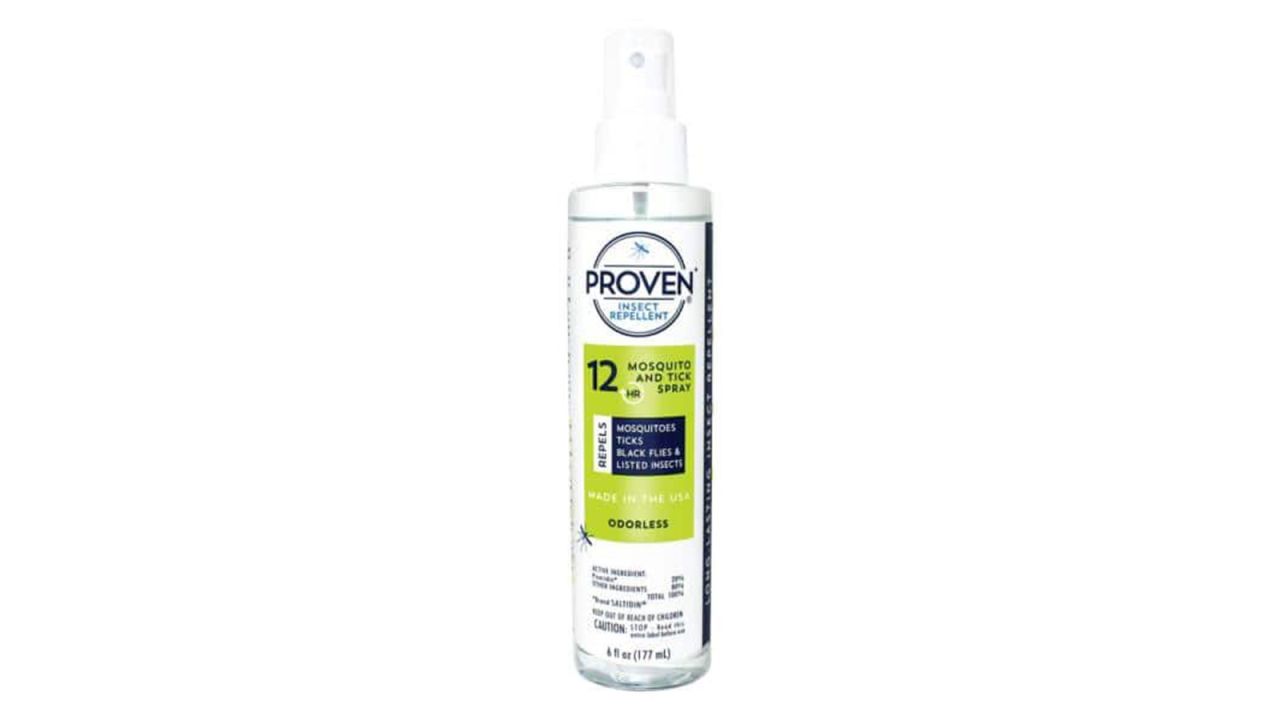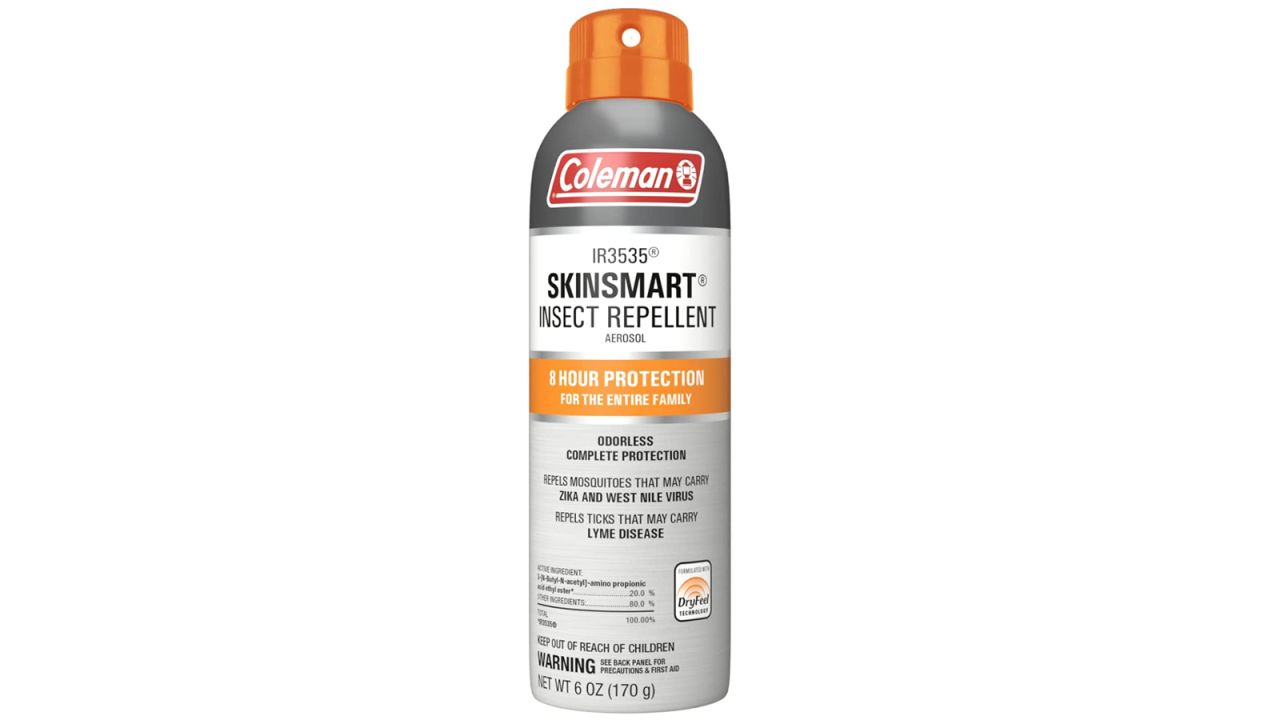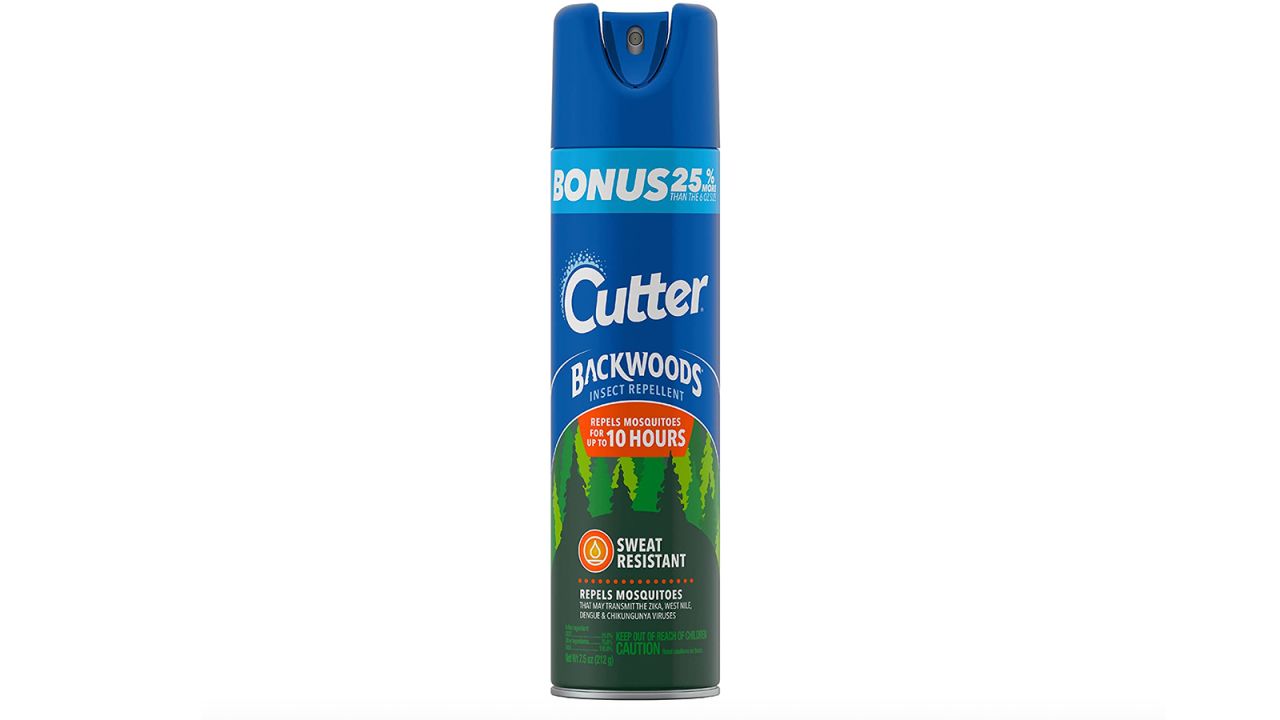The best bug sprays we tested
Best bug spray: Proven Insect Repellent Spray
Best DEET-free bug spray: Coleman SkinSmart DEET-Free Insect Repellent
Best DEET bug spray: Cutter Backwoods Insect Repellent
Best-smelling bug spray: Grand Tongo Town and Jungle Protection Insect Repellent
Best bug spray for camping: Sawyer Premium Permethrin Insect Repellent for Clothing, Gear and Tents
Nothing ruins time spent outdoors like an entourage of pesky mosquitoes chowing down on your arms and legs. Sure, bug spray is great, but between the various active ingredients and concentrations, it’s hard to know what truly works, let alone find a spray that doesn’t smell like a chemistry lab or make you feel like you took a dip in a vat of oil.
That’s why we went hands-on with bug repellents to test how they feel, how they smell and everything else you’d want to know before you use one. We also consulted with multiple experts to ensure we included repellents that are effective at, well, repelling bugs. We only tested bug sprays with active ingredients approved by both the Centers for Disease Control and Prevention (CDC) and Environmental Protection Agency (EPA): DEET, picaridin, oil of lemon eucalyptus, p-Menthane-3,8-diol (which is in oil of lemon eucalyptus), IR3535 and 2-Undecanone. DEET was the resounding favorite among the experts we interviewed, but they also praised the effectiveness of the other ingredients, especially picaridin and oil of lemon eucalyptus.
To be clear, we didn’t test each spray for its efficacy at repelling bugs, since there are so many external variables that go into that. Instead, we used our extensive research, our own expertise and the opinions of experts to choose a pool of sprays that science has proven to be effective.
After months of testing, we found five bug sprays that stood above the rest.
So nice and light you might forget you’re wearing it, though bugs won’t. Picaridin — Proven’s active ingredient, comprising 20% of its formula — is one of the best at repelling bugs.
A 30% IR3535 spray in an aerosol bottle, Coleman SkinSmart has a consistent, wide spray, dried instantly and didn’t leave any greasy residue on our skin.
Cutter Backwoods is a 25% DEET formula, the gold standard in insect repellents. It's very effective, and had the mildest scent and least greasy texture of the DEET sprays we tested.
Great Tongo is a picaridin-based and DEET-free bug spray that offers scents like Green Tea and Mint, and Citrus and Sandalwood. Plus, this spray is one of the best-feeling options we tested, as it goes on nicely and doesn't feel overly greasy.
Best bug spray: Proven Insect Repellent Spray

This picaridin formula from Proven is one of the most portable options, perfect for hikers or for simply stashing in your bag so you’re always prepared. The nozzle, despite its small design, is incredibly consistent and applies evenly. It isn’t an aerosol can, but it’s equipped with a long pump, so spraying felt nice and easy, even though it gets harder when you spray it upside down (since, thanks to gravity, the straw may no longer be submerged). Despite that fact, it didn’t take us a long time to spray ourselves. With an average application time of just over 21 seconds, it was the fastest pump spray we tested.
Proven’s scent is largely, well, nonexistent. Each bug spray went through two separate testers, and both testers who used Proven said they could barely smell anything. No wafting, tear-inducing chemical odor. The Proven bug spray also wasn’t greasy and had a nearly perfect score for the way the spray felt on our skin. It was easy to forget that we even applied this spray — besides the fact that no bug would dare touch our skin.
The Proven repellent was also remarkably portable, thanks in part to its slim bottle. It can fit in basically any bag, but it’s not so small that you’ll easily lose it. (If you do prefer a pocket-size spray, this repellent is available in a smaller, 2-ounce spritzer.) The bottle also comes with a simple cap to protect from any leaks, which held up well during some stress testing. While it doesn’t provide perfect protection because it can fall off, when one of our testers threw it in a bag and went for a bike ride, it stayed completely secure.
We absolutely love the way the Proven disappears on our skin and its basically scentless formula. If you’re looking for an insect repellent that’s easy to use and easy to forget, you can’t get much better than the Proven Insect Repellent Spray.
Best DEET-free bug spray: Coleman SkinSmart DEET-Free Insect Repellent
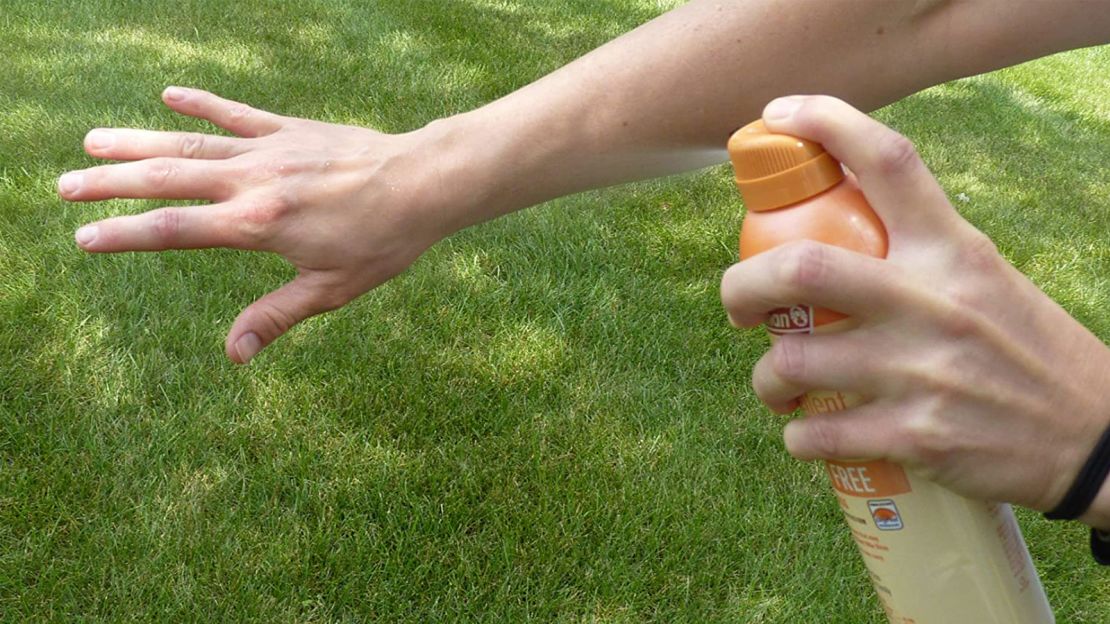
Coming in just shy of first place in our ratings is the Coleman SkinSmart DEET-Free Insect Repellent Spray. It was one of our best sprays in the performance category (which covered tests such as spray smell, feel, quality and others), falling just a little short in portability due to its slightly bulky bottle.
The IR3535 repellent had a wide, even spray that made application a breeze. And since it’s an aerosol can rather than a pump spray, we didn’t have the problem of the pump not being submerged in the spray when applying it upside down. Instead, the aerosol pushes the repellent out, which made spraying our entire bodies a super-fast process. Just be careful of spraying upside down too often because, like all aerosol products, if you do it too much, the aerosol will escape. (We had this happen with a different aerosol spray when we used it upside down too many times, which resulted in repellent stuck in the can with no way to get out. Bummer.)
The feel of the Coleman SkinSmart wasn’t greasy or sticky at all. The formula uses a drying technology that makes it disappear almost instantly on your skin. The only big speed bump we ran into with this spray was its smell. It’s marketed as odorless, and while that rang true for one of our testers, another said it had a smell of chemicals that could easily make you cough when you spray it and that the harsh scent lingered for a while.
Another highlight of the Coleman IR3535 formula is the bottle it comes in. It’s equipped with a locking switch to keep it secure. It was right in the middle in terms of size, not big and bulky but also not slim and packable like some of the other options we tested.
If you’re looking for an aerosol repellent with similar performance to our top pick, and you’re willing to give up some portability, the Coleman SkinSmart DEET-Free Insect Repellent might be the pick for you.
Best DEET bug spray: Cutter Backwoods Insect Repellent

During our research, we found the consensus was that DEET is gold standard when it comes to insect repellents. But despite its reputation, sprays containing DEET didn’t score as well overall in our tests as other options. If you don’t care as much about the smell and feel of the spray and want the science-backed, best-in-class ingredient for repelling bugs, DEET is the way to go.
Out of the multiple DEET-based repellents we tested, the Cutter Backwoods Insect Repellent edged out the competition. It really came down to the Cutter and the famous OFF! Deep Woods Insect and Mosquito Repellent, but the OFF! cap popped off during testing and was the aerosol can that left us with repellent stuck in the bottle, so we had to knock off some points.
The Cutter had a solid spray, though it came out slightly wet and cold at times. The nozzle is larger than the others we tested, resulting in a wide area of application. This, plus its ability to spray upside down, made for ultra-fast application times, clocking in at under 13 seconds on average for mostly full-body coverage.
The spray wasn’t too offensive but was still a little harsh, as it has that classic chemical smell you expect from bug spray. The repellent also left a light residue that took quite a while to fully dry, but it didn’t feel terribly greasy.
While this repellent didn’t perform overly exceptionally or poorly in most of our tests, its biggest downside was the bottle’s size. It’s a bulky spray, which makes it easy to handle but hard to simply throw in your bag for a day on the trails. The size does make it quite durable, though, as both testers noted its sturdy build. And after all the testing and spraying, it still worked good as new, in contrast to some other sprays that had caps pop off or clogged nozzles.
If you’re looking for a DEET spray, willing to sacrifice some comfort in terms of the spray’s feel and smell, and you don’t mind carrying around a larger can, Cutter Backwoods Insect Repellent should top your list.
Best-smelling bug spray: Grand Tongo Town and Jungle Protection Insect Repellent
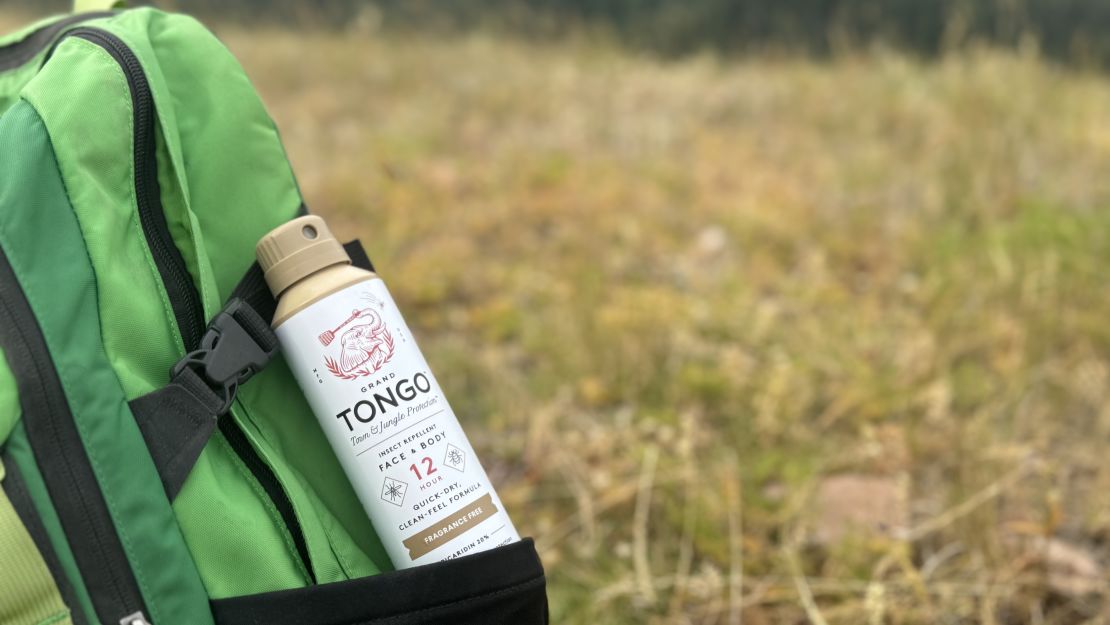
If you’re tired of bug spray that leaves you feeling like you just covered your body with chemicals, Grand Tongo’s Town and Jungle Protection bug spray is a real gift. As mentioned, there are some sensory advantages to using 20% picaridin over DEET, but that’s where Grand Tongo’s innovations start.
When you’re playing outdoors, the strong smell of DEET can take away from your experience. Grand Tongo’s 20% picaridin-based formula avoids this smell and adds a subtle scent that’s?much appreciated when you’re grinding into the woods or down the river. If you plan on backpacking, odor can be a consideration, and it’s nice to have a practical tool that keeps bugs off and gives your skin a fragrant boost.
I preferred the Citrus and Sandalwood scent while my partner liked the Green Tea and Mint. It’s about more than just preference, though. Often we need bug spray the most while fishing. Studies show DEET can be toxic to fish, plus it can damage fishing lines if you’re not careful. For those reasons alone, we preferred Grand Tongo and other picaridin-based sprays.
The canisters for this spray are smaller than most, making them easy to throw in a pack, and their rotating cap lets you close and lock it during transport. Once applied, Grand Tongo dries quickly, so you don’t have that greasy coating many competitors leave. All that aside, this product just looks cool. From its logo (an elephant with a fly swatter) to its scents, it seems the brand had fun bringing this product to life.
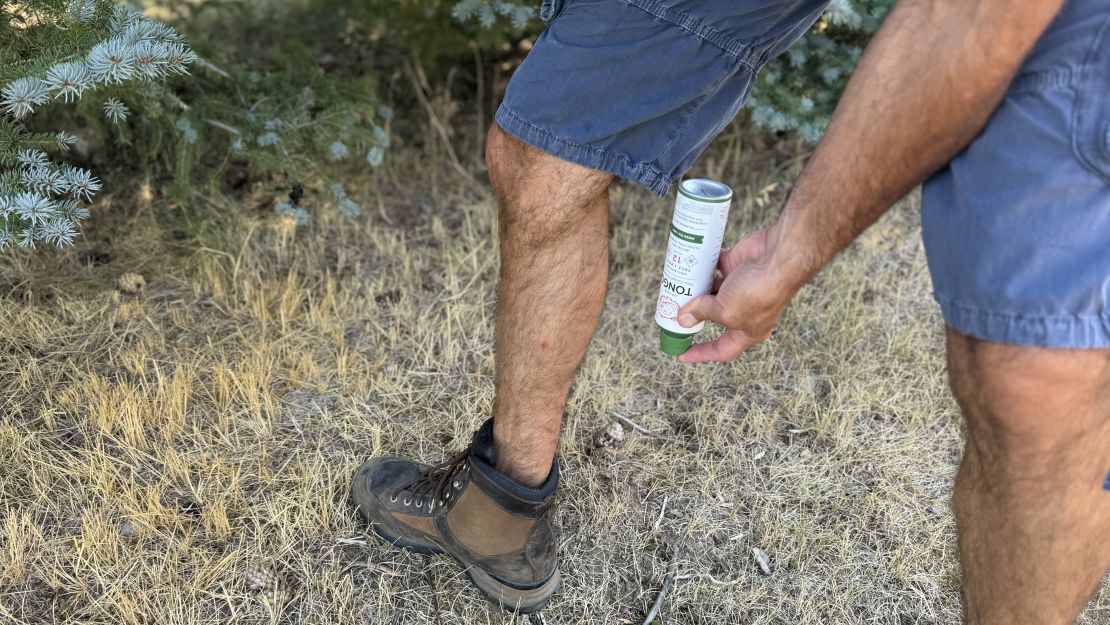
It’s worth noting that Grand Tongo Town and Jungle spray is one of the more expensive sprays on our list, and that’s for a smaller canister than others offer. Plus, we noticed a squealing sound when applying the spray that you might find jarring. The sound comes from the brand’s ambient air, nonaerosol, continuous spray technology, which is more eco-friendly and helps with applying the bug spray quicker and more evenly.
Grand Tongo’s bug sprays don’t feel the least bit intrusive and offer unique scents for a little happiness kick on any forays into the outdoors. Plus, when you buy a spray from Grand Tongo, you’re supporting a quality, eco-friendly company. If you’re looking for an effective bug spray that smells and looks good, Grand Tongo needs to be in your pack.
Best bug spray for camping: Sawyer Premium Permethrin Insect Repellent for Clothing, Gear and Tents
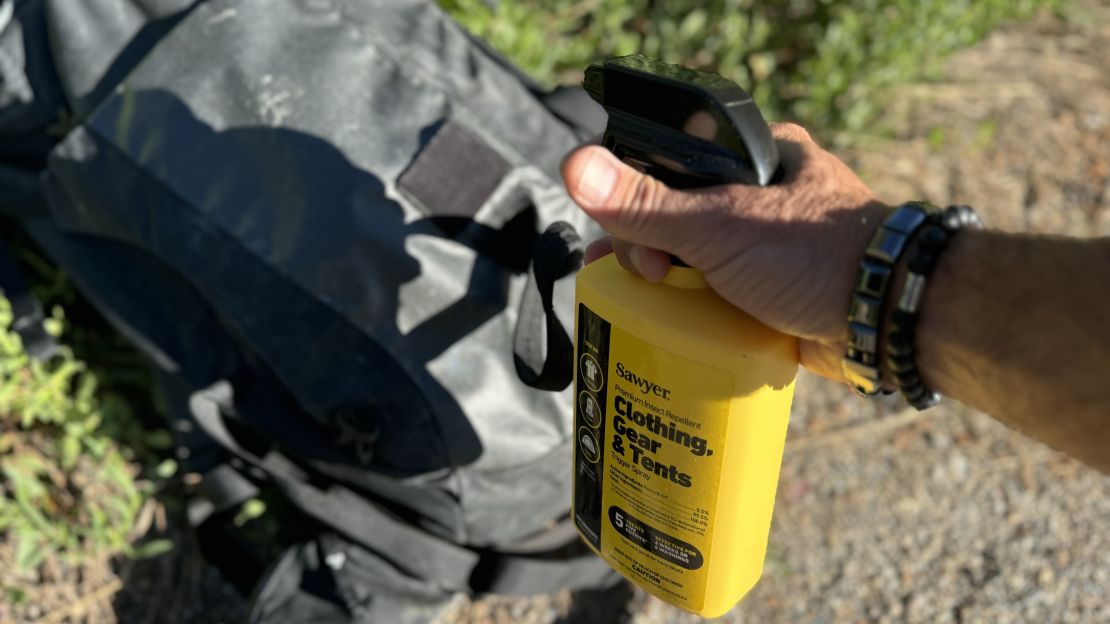
I will forever remember a backpacking trip into the Wind River Range when the bugs were so bad my wife and I sprayed a DEET bug spray all over our tent. She woke up with a horrible headache that lasted the rest of the weekend. Sawyer’s Premium Permethrin Insect Repellent for Clothing, Gear and Tents would have saved that camping trip.
To start, it uses permethrin, which is mostly scentless. Even if we’re not talking about the unpleasantness of DEET bug spray scents, those smells and the chemicals that cause them can have actual effects on your physical health. Unlike DEET, permethrin doesn’t eat through gear, so you can spray it on about anything and keep bugs away from your clothes and gear while you reap the benefits.
There’s more than just field performance at stake here for this Sawyer’s insect repellent. Since it goes on materials instead of skin, you can get ready for a trip into bug-infested wilds before you even leave your home or car. Cover your tent, backpack, jacket and clothes at home by spraying on a thin layer. This process feels almost like re-waterproofing your gear.
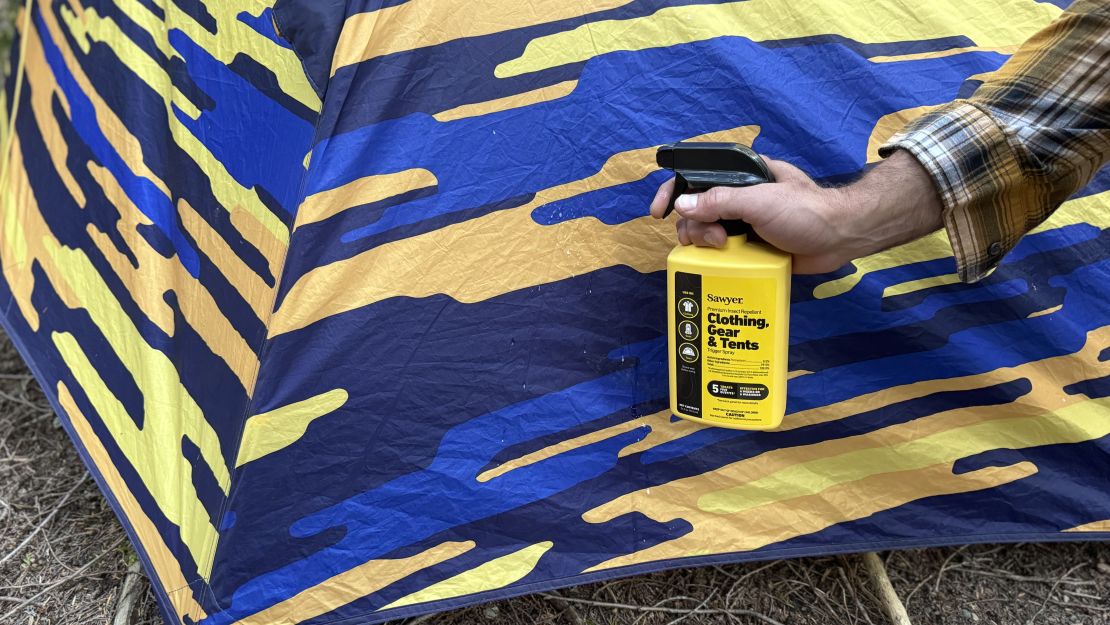
I liked how easy it was to cover my tent compared to spraying my body. Since it lasts six months (or six washings), my tent will be covered until long after bug season. This is especially important since it took well over a minute to spray my two-person tent. My backpack was a bit quicker, but still, the application is slow if you do it right. Once done, you’ll be in good shape for a while. This spray also sets up a sort of force field around my tent, which kept me comfortably unaffected during a warm, wet July day by a creek in Montana.
I will note, though, that Sawyer’s Premium Permethrin Insect Repellent for Clothing, Gear and Tents comes in such a big container you’ll want to apply it before heading out. Even while driving with it in my car during a car-camping trip, I was nervous about it getting crushed by something and spilling. This can be seen as a benefit, though. It’s one less thing to take with you in the backcountry because, well, you can’t take it. Just spray, let it set and enjoy its repellent nature.
The spray itself is an invisible, undetectable coat that can go on everything that covers you and works much longer than any on-the-skin spray. If nothing else, it’s a must-have for your bug-deterrence kit. Though depending on the conditions, it’s effective enough that it might even be the only bug spray you need.
How we tested
We ran each bug repellent through the same tests to measure both performance and portability. We did not test each spray’s ability to physically repel bugs, but instead relied on our extensive research and the opinions of experts we interviewed to create criteria that all the repellents we tested met. Our performance ratings, rather, were based on tests that examined the physical quality of spray, smell and feel, among other things. Since many of these tests are subjective, we had two testers evaluate each repellent and took the average of both results. Here’s a full breakdown of every test we ran.
Performance
- Spray quality: We tested how wide, even and consistent the spray was by applying it multiple times on ourselves.
- Spray smell: We smelled the spray whenever we applied it and noted how strong or weak it was, as well as if it was a pleasant or harsh smell.
- Spray feel: We noted how the spray felt on our skin whenever we applied it and if it was greasy or sticky.
- Spray difficulty: We tested how hard it was to spray ourselves with each repellent, noting how hard it was to hold each bottle and if we could spray it upside down.
- Spray time: Each tester timed and sprayed themselves three times with each repellent, and calculated the average time it took to spray themselves. We then averaged the results from both testers to come up with an average spray time.
- Spray durability: After conducting all our other tests, we observed how the bottle held up and if the quality of the spray was affected.
Portability
- Leaks: We examined each bottle and looked for any sort of locking mechanism or cap and judged how likely it would be to leak in a bag.
- Size: We noted how large each bottle was and threw it in a bag to see if it took up a lot of space.
- Size options: We researched how many size options are available for each repellent.
How to pick the right bug spray
We tested 14 bug sprays after thoroughly researching the most effective ingredients and talking to several experts to find the best at repelling flying and biting insects. We chose only repellents with both an active ingredient that is both?CDC and?EPA approved, which are DEET, picaridin, oil of lemon eucalyptus, p-Menthane-3,8-diol (which is a component of oil of lemon eucalyptus, but they are regulated separately), IR3535 and 2-Undecanone.
Our experts largely echoed the CDC and EPA, praising the effectiveness of all these ingredients but heralded DEET above all else as the industry standard. “DEET is still the gold standard to many in the public health profession,” says?Elmer Gray, public health extension entomologist for the University of Georgia Cooperative Extension Service. Many of his peers also agree.
“The gold standard for insect repellents is still DEET-based products sold under a whole host of brand names,” agrees?Dr. Jerome Goddard, extension professor of medical entomology at Mississippi State University. “Many studies through the years have demonstrated its effectiveness against a variety of flying insects and (somewhat) against ticks.”
While some may harbor concerns over DEET’s safety and its toxicity, all the experts we talked to said those worries are largely unfounded. “The first law of toxicology is that everything is toxic,” says?Dr. Jeffrey G. Scott, professor of insect toxicology at the department of entomology at Cornell University. “It’s just the dose that determines the effect.” The?EPA has concluded?that DEET is safe, and many of the worrying stories of people getting seizures or even dying came after ingestion or “dermal applications not consistent with label directions,” according to the EPA.
The EPA has been testing DEET for decades and found that if used as directed, it is completely safe for everyone, even pregnant women and children over 2 months of age. However, repellents with the active ingredient oil of lemon eucalyptus and p-menthane-3,8-diol?aren’t recommended for children under the age of 3?because the dangers of applying them to kids under that age?haven’t been thoroughly explored.
The CDC recommends using products with an active ingredient concentration of more than 10% for limited protection and says that the effectiveness of DEET plateaus after 50%. The experts we talked to agree. “In general, higher concentrations of an active ingredient provide longer duration of protection, regardless of the active ingredient,” says?Dr. Eva Buckner, assistant professor and state extension specialist at University of Florida’s Institute of Food and Agricultural Sciences Medical Entomology Laboratory. “However, concentrations above around 50% do not offer a marked increase in protection time. Products with less than 10% active ingredient may offer only limited protection, often from one to two hours.” Following that guidance, all the repellents we tested have between a 10% and 30% concentration of their active ingredients.
Even with regular repellent application, you may occasionally be bitten — and if you consider yourself a mosquito magnet, you’re probably very aware of when you are. If you’re the kind of person who seems to attract mosquito bites, we’ve found that the viral?suction-based Bug Bite Thing?can provide relief, as long as you keep it on hand and use it immediately. Otherwise, a variety of topical applications, ranging from?hydrocortisone?creams to treatments like?After Bite?may help.
Other bug sprays we tested
If you prefer Picaridin over DEET, a lotion over a spray and the smell of sunscreen over harsh repellent chemicals, Sawyer’s Picaridin Lotion might be your new favorite bug “spray."
Sawyer’s Picaridin Insect Repellent Lotion offers a new take on an old outdoor staple. If you’ve ever noticed the ineffectiveness of sunscreen spray compared to sunscreen lotion, an argument can be made that lotion is the only way to ensure all-over coverage. Sawyer’s picaridin 20% formula gives standard protection and the lotion not only makes for easy application but helps with portability.
The lotion comes in a smaller, more packable bottle than most metal spray canisters. Unfortunately, its greatest advantage is also part of the reason this lotion didn’t make the list. While it’s a great alternative to bug spray, the ability to quickly cover yourself is vital when you’re suddenly in a mosquito hatch. Rubbing this on took three times as long as most sprays. Sawyer does offer this in a quality 20% picaridin spray as well, but we preferred the lotion and wanted to highlight it.
When playing in the woods or on the water and the bugs are striking with a vengeance, sometimes you need to go with the strongest bug spray you can handle. In most cases, the Repel Sportsmen MAX 40% DEET brings all the extra protection you need.
Sometimes the bugs are so bad you have no choice but to reach for some tried-and-tested DEET. In this case, Repel’s Sportsmen MAX 40% DEET has your back. I’ve opted for this spray on several occasions while fishing in the swampy rivers near my house. Of all the options tested, the DEET smell is quite strong here and it was one of the greasiest after application. It also took the longest to wear off, which can be a pro or a con depending on the day you have planned.
If you’re careful with a slightly more delicate can and avoid spraying it upside down too much, then the OFF! Deep Woods repellent is a top-notch pick.
This spray was one of the leaders early on in the testing process, but it dropped in the rankings after some durability issues. The cap popped off in a bag during a day of hiking, and after some serious spraying (much of it upside down), the aerosol in the bottle ran out, resulting in a can that still has bug repellent in it with no way to get it out.
Ben’s has an incredibly strong, unpleasant and chemical smell most people may not like. It also goes on thick with a wet feel that had our testers antsy for a shower.
This bug spray from Ben’s has a spraying mechanism that mimics the distribution you’d get from an aerosol can without actually using any of the gas. However, the spray came out extremely dense and sticky, which outweighed any of its other benefits.
The pump spray on the Sawyer repellent provided short little spritzes that didn’t cover much area, so we found ourselves spraying a lot to get even coverage. Its small size makes it a little difficult to hold and spray all around, but it doesn’t have a strong smell. It dried quite quickly, but the pump also got clogged quite a bit during testing. The highlight was the double-locking lid, which ensured a leak-free experience.
This picaridin option from OFF! impressed our testers, with a wide aerosol spray and a fast-drying feel.
One tester of this OFF! FamilyCare spray said she didn’t smell anything when she applied it and another smelled orange peel, so even if you do smell anything, it’s not a harsh, eye-watering scent. This repellent scored highest in our performance category, but it doesn’t have a cap or lock, is a little bulky and comes in just one size, which knocked off some points. Only one point behind our runner-up, Coleman SkinSmart spray, it’s still a high-quality option.
This repellent is made with p-menthane-3,8-diol, but its tiny size and small pump make it hard to apply.
This spray from OFF! doesn’t apply particularly evenly and sometimes just squirts a jet of spray instead of a mist. However, it didn’t have a scent at all, which was a huge bonus. It’s also available in one of the smallest size options (2 ounces), so if you want a truly tiny spray you can fit in your pocket, this one could be for you.
The scent of this lemon eucalyptus spray was polarizing for our testers. One loved the herby tones and the other was left coughing because of its strong and pungent smell.
This lemon eucalyptus spray from Repel was the hardest for our testers to agree on. Some couldn’t stand the smell while others thought it smelled amazing. Even if you enjoy the scent, we’d recommend applying it outside, as it is quite strong. This repellent was also extremely greasy and took a while to dry. Similar to Ben’s spray, the first thing we wanted to do after applying it was take a shower.
Coleman's Botanicals Insect Repellent is oilier than other options, and the spray dripped around the nozzle, making it a little messy.
This spray had a pleasant smell due to its oil of lemon eucalyptus base, although it was strong at times. The pump worked well, but it took too long to apply and the bottle is a bit stubborn: You can’t spray it upside down due to its pump function, and it’s easy for your finger to slip off the small nozzle.

